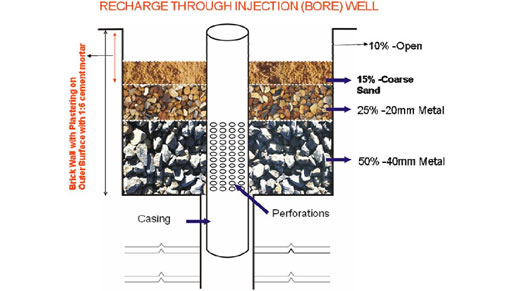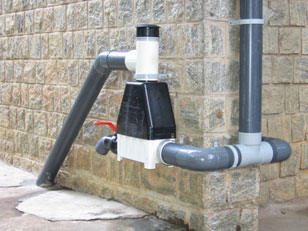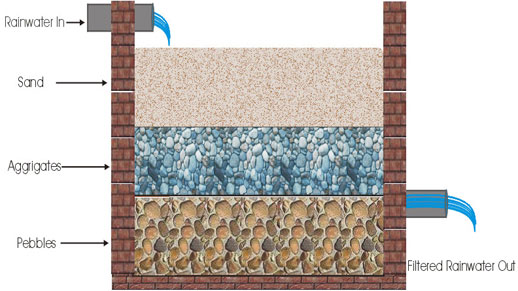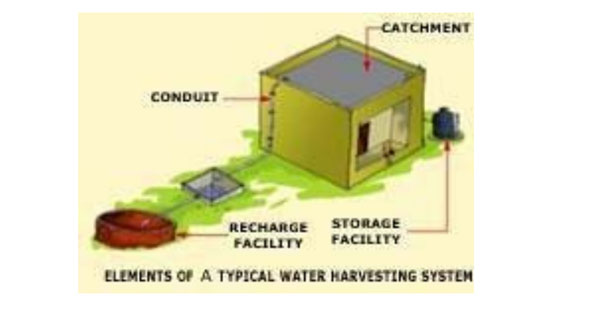
Your dream home should last for generations
use the best quality Cement.
WATER HARVESTING – AN INTEGRAL PART OF HOMEBUILDING
Progress in technology has detached us from our environment. But a good summer shower, bringing the temperatures down, never fails to make everyone look up at the sky and wonder about this amazing gift of nature – rain!
Drying up of wells and bore wells, shortage of drinking water, plants drying up because of lack of watering are common problems during summer. The blame often falls on the neighbour’s deeper bore, lack of fair distribution by the authorities, etc. In all this, we forget that underground water, rivers, ponds etc. are secondary sources of water. The primary source that feeds them is rain. Hence, it is of utmost importance to tap this primary source of water in the best way one can to take care of the ever increasing demand of water in urban areas.
As much attention is not being paid to the primary source of water in the Hydrological Cycle, the secondary sources are all drying up. We forget that it is rainwater that flows into the natural reservoirs of water, refills them, infiltrates into the ground and replenishes the ground water that we use. But it has become difficult for rainwater to penetrate into the ground or reach natural reservoirs in the urban areas. This is because of the large amounts of paving and concreting, leaving very little open soil for water to seep into the ground. Further encroachment of natural drainage channels and urban lakes for creating high-value urban land adds to the problem. Hence, a large amount of rainwater ends up in sewage drains and gets wasted, or is unable to find a way out and gets collected in the low lying areas leading to urban flooding.
Water Harvesting in Urban Areas
Essentially, the concept of water harvesting is collection of rain water. Rain water is collected from areas like the roof of the house (flat or sloping), paved floors, and any other small or big catchment areas which are reasonably free of contamination.
It is an easy process. Once collected, the rain water can be harvested in two ways ‐‐
1. Direct Use i.e. the collected rainwater is filtered and stored in an underground sump, small open pond or any other water collection container, and can be directly used for purposes like gardening, car wash, etc.
2. Artificial Recharge to Groundwater i.e. the collected rainwater is used to recharge the ground water through specially planned and designed structures that filter the water and help in the seeping of water into the ground. Percolation of the water into the ground helps in the recharge of bore wells, open wells, hand pumps etc.

The amount of rainwater that can be harvested from the roof can be calculated by knowing the annual rainfall of that area.
In a place like Hyderabad, the annual rainfall is recorded at 800mm or 0.8 meters
Since all the water falling on the roof cannot be harvested considering the loss due to evaporation, first flush wastage, run off, etc., it is assumed that up to 95% of the total rainwater falling on the roof can be harvested. The percentage collected depends on the type of the catchment area.
Hence, for a concrete roof of 100 square metres with a rain fall of 800mm and a collection efficiency of 95% percent, one can collect about
100sqm*0.8 m*1000 l*0.95=76000 litres annually
Run-Off Coefficients for various surface
| Surface Type | Run-off Coefficients |
| Roofs | |
| Roofs Conventional | 0.95 |
| Tiled roof | 0.90 |
| Corrugated metal sheets | 0.90 |
| Roof Garden < 100 mm thik | 0.50 |
| Roof Garden 100-200 mm thik | 0.30 |
| Roof Garden 200-500 mm thik | 0.20 |
| Roof Garden > 500 mm thik | 0.10 |
| Ground surface covering | |
| Concrete / Kota paving | 0.95 |
| Gravel | 0.75 |
| Brick Paving | 0.85 |
| Vegetation | |
| Slope 0-1% | 0.10 |
| Slope 1% - 3% | 0.20 |
| Slope 3% - 10% | 0.25 |
| > Slope 10% | 0.30 |
| Turf Slopes | |
| 0% - 1% | 0.25 |
| 1% - 3% | 0.35 |
| 3% - 10% | 0.40 |
| > 10% | 0.45 |
| Rocky natural catchments | 0.50 |
(source: Environmental Building Guidelines for Greater Hyderabad—Ver 1.2. (2009),HMDA website)
Rainwater directly collected from the sky is largely very clean unless it is falling in areas with known atmospheric pollution. Yet, when it hits the ground, all kinds of dirt, dust, bird droppings, fallen leaves, etc. from the ground make the water unclean and also end up clogging the pipes. Hence, it is important to filter the water before storing.
The filters used in the cleaning of the rainwater are of different types and is suitable for different purposes of cleaning the rain water.
Here are some of the filters needed at residential level

- Conical mesh filter – helps filter dry leaves and debris.
- Pop-up filter- helps filter dirt and other small particles.
- Sand bed filter- layers of pebbles, aggregates and coarse riverbed sand are laid one over another in a confined masonry structure. Rainwater enters from the top end and filtered water is drawn from the bottom end.

Sand bed filter- layers of pebbles, aggregates and coarse riverbed sand are laid one over another in a confined masonry structure. Rainwater enters from the top end and filtered water is drawn from the bottom end.
Water from the first rain up to the first 20 minutes is not collected and is referred to as first flush. This rainwater cleans up the catchment area for rainwater harvesting and the water collection is done thereafter.
Hence, the basic elements of a rainwater harvesting system are,

- a catchment area for the rainwater,
- conduits for carrying the rainwater,
- filter to filter the water at various levels,
- storage facility for storing the clean water, and
- A recharge facility for the percolation of the rainwater.
This complete system needs regular cleaning and maintenance. But it is easy to do, as it does not require any specialized knowledge and a visual inspection is enough to spot problems.
With the growing need for water harvesting and increased technical support from the government, it is time all homes consider this as an integral part of home building.
Gouri Mohini Kasinathuni
Freelancer Architect, Hyderabad Back
Back